Royal Decoration for Peter Barthel
On Friday 24 April 2015, Prof. P.D. (Peter) Barthel has been made Knight of the Order of the Netherlands Lion.
Prof. P.D. (Peter) Barthel

Peter Barthel (1952), Professor of Astrophysics of Active Galaxies, has been a staunch and active supporter of sharing science with the masses since starting his PhD research. He is a gifted speaker with a knack for making young people enthusiastic about his field. This intrinsic passion fuels his commitment to the orientation and information activities organized by the Faculty of Mathematics and Natural Sciences, which include the Science Support Desk to help secondary school pupils with profile assignments and a ‘schools network’ in which the University works together with school teachers. Thanks to Barthel’s enthusiasm, these activities resulted in the foundation of the Pre-University College, an activity that introduces secondary school pupils to the University and gives them a good impression of the programmes on offer. The Children’s University for primary schoolchildren is also part of the Pre-University College.
As a member of the Primary and Secondary School Education Committee at the Royal Netherlands Academy of Arts and Sciences (KNAW), Barthel helps to devise educational policy designed to whet schoolchildren’s appetite for science and build on the teachers’ professional knowledge.
Barthel is one of few professors who possess the flair to reach pupils in primary and secondary education. He regularly gives guest classes and lectures, and has managed to get these activities embedded into the organization.
Herschel infrared satellite
In 2008, Barthel headed the ‘Discover the invisible universe’ project, based on results from the Herschel infrared satellite. The project won him the Academische Jaarprijs. The team divulged the secrets of infrared light to audiences of children and adults, and explained about the infrared astronomy research being carried out in Groningen. The University of Groningen Discovery Truck visited a number of schools and an infrared photo competition with professional photographers was organized for the under-16s.
In 2010, the mobile planetarium was put into operation. The purchase was partly funded with the prize money from the Academische Jaarprijs. The mobile planetarium is an inflatable dome. A special projector and digital planetarium software are used to project the solar system ‘full dome’ onto the inside of the planterarium. Stellar movement can be simulated and the operators can zoom in on unusual objects in the universe. As the solar system is projected onto the entire dome, visitors feel as if they are really looking up at the stars. Schools can make an appointment to visit the dome.
In 2013, the Board of Stichting De Koepel awarded Barthel the Willem de Graaff prize. The prize is primarily intended for people who work in astronomy and/or space research, and who have made an exceptional contribution to popularizing this field of science.
After being conferred with a PhD by Leiden University, Peter Barthel went to the prestigious California Institute of Technology, where he developed his ideas for a simple, effective unification model for radio galaxies and Quasars. This model is still the prevailing model for studying the structure of active galactic nuclei.
Barthel switched the focus of his research to star formation around active nuclei, a move that was made possible by new space observation facilities, such as the Hubble Space Telescope and infrared satellites. The ESA Herschel satellite, for which he was a mission scientist, was one of his main sources.
Star of Bethlehem
As an active member of the Protestant Church in Bedum, Barthel feels it is his duty to share his scientific knowledge with others. To him, science and faith are not mutually exclusive. He regularly gives lectures (often in churches) about the link between religion and astronomy. As part of the University of Groningen ’ s 400th anniversary celebrations, the public was invited to ask questions. A 7-year-old boy asked the question: ‘Does God exist?’ The person who answered this question was not a theologian, but Barthel, an astronomer. This was also the case at another anniversary activity organized by the University, a two-day symposium about the Star of Bethlehem, at which various different academic fields were represented.
Barthel is also a gifted pianist. During the Year of Astronomy, his contact with fellow astronomer/composer Sisask led to a new composition by Sisask, Sombrero, performed by and dedicated to the Grieg piano duo and Barthel. Barthel was responsible for the images of the universe projected throughout the production. It would be hard to imagine anyone who would be better than Barthel at bringing together and presenting these two very different, unique worlds. He is also a member of the Board for the Grieg foundation, an organization that aims to raise awareness of Grieg in the Netherlands.
At a different level, his chairmanship of the Senior Academy is further proof of his passion for sharing academic knowledge with a wide (and largely unscientific) audience.
More news
-
19 December 2025
Mariano Méndez receives Argentine RAÍCES award
-
18 December 2025
Why innovate, and for whom?
-
17 December 2025
Ben Feringa wins Feynman Prize
